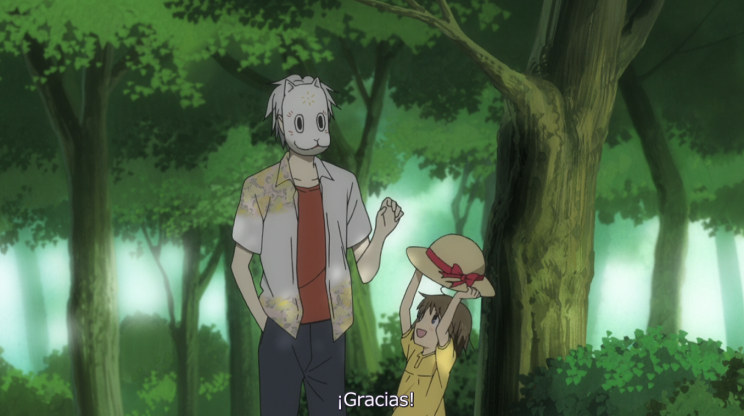This ‘movie’ was a bit longer than other offerings, about 45 minutes, and is a self-contained tale. The only problem I had with “Hotarubi no Mori e” (“Into the Forest of Fireflies’ Light”) is that I knew how it was going to end before I got there and that is always a grand disappointment.
The story starts out with a six-year-old girl named Hotaru Takegawa, who gets lost in a forest inhabited by a yamagami, or mountain spirit, as well as various yokai. Her grandparents have a cabin there and she comes to visit for the summer. She is found by a mask-wearing, human-like entity named Gin, who informs Hotaru that he will disappear forever if he is touched by a human. Gin then leads Hotaru out of the forest after a delightful series of actions between Hotaru and Gin. Hotaru returns to visit Gin in the forest over the next few days and they become friends despite the limitations on their interactions. Although at summer’s end she must leave Gin to return to the city and continue her studies, Hotaru promises to return to visit him every summer holiday.
We then see them over the next 10 years, as she grows and matures, but Gin hardly ages. We learn of the circumstances that caused him to be a mountain spirit, but as to how old he really is, no one can fully tell. Even the yokai come to accept her and try not to scare her too much. An event that does occur on the mountain is a festival hosted by the forest spirits. Hotaru even mentioned that some of her relatives may have snuck in to participate many years ago, as it was modelled after human festivals. Although they have a wonderful time, tragedy strikes.
It is a very good-looking film and if you feel it sometimes draws references from “Natsume’s Book of Friends”, it is done by the same person. It is a very gentle film, with a lot of heart and soul and humor. Could it have gone full length? Hard to say. We could have seen how Hotaru grows up and all her plans for the future and not have it come off too episodic. At the festival, she confesses to Gin what she wants to do when she leaves high school. But if we doubled the time, would we have lost something in the process? Did we consciously make a comment about how the passage of time always seems too brief, thus keeping the film short? Did we just not have enough material to lengthen it out logically? (It was a one-shot manga).
I ask these questions as there was a feeling of incompleteness, as though there were deeper or hidden parts of the story to tell, but a management decision kept up at the short-time offering that we are presented with. If you have a chance to see this, I recommend it highly. It is a wonderfully presented story about what true friendship means and accepting people (or spirits) for what they are.
On a scale of 1 to 10:
Artwork 9 (Executed with near-perfection)
Plot 8 (Although predictable, still charming)
Pacing 8 (Moves along quite nicely)
Effectiveness 8 (More touching than I realized)
Conclusion 6 (It reaches a ‘coupler point’, but could potentially be over)
Fan Service 0 (A similar show would be “Honey and Clover”)
Overall 8 (The telegraphed outcome hurts)
And remember, it’s first run until you’ve seen it. I will return next summer.

